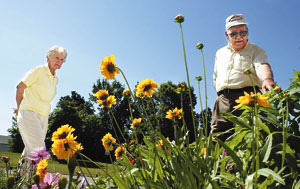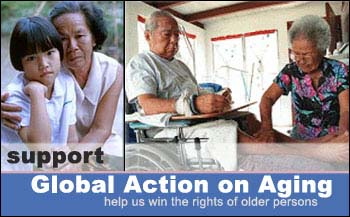
back
|
 |
Seniors
losing ground in housing
By Dolores Orman
Democrat and Chronicle, July 16, 2003
 Robert
Rice points out the new blooms in the garden to his wife, June, at Ada
Ridge Court in Greece. Though the area has experienced a boom in housing
for the elderly, people with low or moderate incomes still face long
waiting lists. Robert
Rice points out the new blooms in the garden to his wife, June, at Ada
Ridge Court in Greece. Though the area has experienced a boom in housing
for the elderly, people with low or moderate incomes still face long
waiting lists.
There’s a boom here in housing for the elderly, but it’s
bypassing older people with low or moderate incomes.
The waiting lists for the relatively few units available to people with
lower incomes are long, and experts says the situation is only going to
get worse as the number of elderly people increases.
“There’s a lot of new senior housing going up, but it’s not the
affordable kind that most seniors are looking for,’’ said Sandy
Schencke, senior elder care specialist with Eldersource, a local referral
service for the aging sponsored by Lifespan and Catholic Family Center.
“It’s more for those people that can afford $1,000 or higher (per
month).’’ And that’s a small percentage of the general senior
population, she said.
According to 2000 U.S. Census data analyzed by Lifespan, Social Security
is the only source of income for 20.3 percent of the 112,584 people in
Monroe County age 60 and older who are not in institutions. Social
Security represents 50 percent or more of the total income of 47.8 percent
of that population. The average annual income is $18,812.
The American Association of Homes and Services for the Aging based in
Washington, D.C., puts the affordable housing issue in national
perspective.
“What we have identified - there are about 1.4 million seniors who are
spending more than half their income on housing,’’ said Bruce
Rosenthal, an association spokesman. He added that most of them are of low
to moderate income. “For each unit of federally assisted housing that
becomes available there are nine seniors on the waiting list.’’
 The elderly most in need are those who, for whatever reason, can no longer
live in their own homes, yet are healthy and independent and not ready for
a nursing home or adult-care facility.
The elderly most in need are those who, for whatever reason, can no longer
live in their own homes, yet are healthy and independent and not ready for
a nursing home or adult-care facility.
Rural Opportunities Inc., a nonprofit regional community development and
human service organization that also owns and/or manages affordable
housing rental units, is one of the few organizations locally that is
addressing the need for affordable housing among senior citizens.
In October 2001, the organization opened Ada Ridge Court, a 49-unit senior
apartment complex on Long Pond Road in Greece. The agency now has a
minimum two-year waiting list of more than 100 people, said Kathryn Bryan,
director of property management and resident services for Rural
Opportunities.
The organization is constructing a 64-unit affordable senior apartment
complex on Brower Road in Irondequoit, and, although they haven’t
started leasing units yet, more than 60 people are on the list of those
interested, Bryan said.
The lucky ones
Margaret Wickware, 68, is one of the fortunate people who got an apartment
at Ada Ridge Court. Because she also qualifies for a subsidized rent
program through another organization, the monthly rent she pays for her
one-bedroom apartment is less than the affordable rate: $275 vs. $335.
She moved into her first-floor apartment at Ada Ridge Court in late
November 2001. She is happy with her new surroundings. “I love sitting
here, looking out the window,’’ she said.
For Robert and June Rice, Ada Ridge Court has meant change in lifestyle.
The couple had lived in a large 150-year-old home in Colden, Erie County,
a small community south of Buffalo. “This is our first experience of
renting in our lives,’’ said June Rice, 72. “Going from a house, you
have to get a different mindset.’’
The rising cost of keeping up their home had forced the decision to sell
their house, which Robert Rice had purchased through the GI bill. “It
was getting to be too much work,’’ said Rice, 80, a retired employee
with an office furniture company. “Besides, we were running out of
money.’’
They planned originally to remain in the Buffalo area, but their two
daughters, who live in Gates and Greece, convinced them to move to the
Rochester area because of some health-related emergencies the couple had
experienced. They were among the first tenants when they signed a lease in
fall 2001 for a first-floor, one-bedroom apartment.
Robert Rice enjoys working his small garden out back of his apartment, and
both appreciate the affordable rent: $335 per month.
The maximum income limits to qualify are $19,900 for a one-person
household and $22,750 for a two-person household.
“There’s a definite need for this kind of building,’’ said Robert
Rice. “The prices, the way they are, people run out of money.’’
Housing trends
Ada Ridge Court doesn’t provide support services and amenities such as a
dining room or meals, a hair salon, transportation and social activities
that are often available at more expensive facilities. Senior housing that
provides such services is the growing trend in the industry but it is not
readily available to low- and middle-income elderly.
“We’re a for-profit company,’’ said Christopher A. DiMarzo, vice
president of Mark IV Construction Co. “The not-for-profit company can do
that (provide low-income housing) efficiently, but we can’t. We just
decided we haven’t gone in that direction for financial reasons.’’
Nonprofit developers, such as church-affiliated nursing homes, also are
entering the assistive housing market aimed at middle-income seniors.
Timothy H. Poley, president of Strategic Consulting Associates, a Honeoye
Falls-based firm that focuses on real-estate strategies, believes the
entry of nonprofit developers has produced a problem for private
developers.
“It’s a little bit unfair they can compete on the same playing field
with the advantage of not paying the real estate and income taxes.’’
he said.
The Friendly Home, a nonprofit, is sponsoring a public celebration event
Sunday afternoon at the site of Cloverwood, its mixed senior housing
development under construction on Toby Village Road near Clover Street in
Pittsford. The project won’t be completed until next year.
Another nonprofit, St. John’s Home, owns a mixed senior housing
development off Elmwood Avenue in Brighton called St. John’s Meadows.
The goal was being able to provide a range of different types of housing
with support services “that are financially in reach of the
broadest’’ section of the community possible, said Gerald Stryker,
executive director of St. John’s Meadows. Amenities include a fitness
center, an indoor heated swimming pool, barbershop and beauty salon. Rents
range from $1,135 to $4,050.
But there also is a so-called “affordable’’ rent plan of $517 to
$618 that applies to 20 percent of the 176-unit apartment building called
Chestnut Court.
Doris Shoemaker, an 85-year-old widow living at St. John’s Meadows, pays
a monthly rent of $1,442 for her two-bedroom apartment in Chestnut Court.
She also pays $18 for cleaning service twice a month.
Living in the complex “is like family. Everybody is concerned about
everybody else,” said Shoemaker, whose husband, Donald, a retired
businessman and former state legislator, died in February.
Working for more
Rural Opportunities is working to provide resident services at all of its
affordable housing locations, such as nutritional counseling, and help
with budgeting, transportation and Medicare and Medicaid issues.
The group received a $489,000 federal grant last year to set up such a
program at the 519-unit Crossroads Apartments on St. Paul Street in
Rochester.
Experts in the field of affordable senior citizen housing expect the need
to grow rather than diminish and become even more critical by 2020.
“Senior individuals who are able to remain in the community should
receive the services they need to be as independent as possible,’’
said a June 2002 report by the national Commission on Affordable Housing
and Health Facility Needs for Seniors in the 21st Century. “Those who
must move from their preferred setting should have viable and affordable
alternatives that ensure their well-being. Neither institutionalization
nor neglect should be the only alternatives they must accept.’’
Copyright
© 2002 Global Action on Aging
Terms of Use | Privacy
Policy | Contact Us
|



